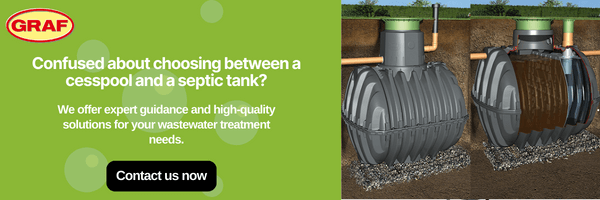Upon first sight the difference between a cesspool and a septic tank may not be easy to pinpoint. However, there are some crucial differences between the two systems and by understanding how each one works, you can make the right choice for your property and land.
Cesspools and septic tanks are two simple methods of wastewater treatment and in this article we explain what they are and how they work in more detail.
What is a cesspool?
A cesspool can be used as a place to hold wastewater and sewage produced in a nearby property. It’s a self-contained chamber that sits underground and does not offer any type of water treatment.
There is one inlet and no outlet in a cesspool, with wastewater entering and filling the tank until full. This will then have to be manually emptied in order for the cesspit to be used effectively again.
Modern cesspools often come with in-built alarm systems that alert owners when the tank is three- quarters full. This ensures they do not have to rush to empty the tank at the last minute and deal with any unnecessary clean ups.
What is a septic tank?
A septic tank is designed to hold wastewater before separating different elements within the tank. Wastewater derived from baths, showers, sinks, toilets, washing machines and dishwashers are just some examples of what can be sent to the tank.
Solids will settle before decomposing, while separated liquids will be able to exit into the drainage field. This is the key difference compared to a cesspool, as a septic tank filters the waste and processes it.
How often a septic tank will have to be emptied depends on a number of factors, but a tanker company should be hired at least once a year to ensure it continues to perform to the required standard.
Septic tanks are typically made from two types of materials:
Brick
Septic tanks made from brick will usually feature two separate chambers. The wastage is divided once the water level reaches the outlet pipe and it overflows into the other chamber.
Dip or T-pipes installed within the tank will ensure solids remain inside so they do not exit into the outside environment.
Three layers of solids will contain dense matter such as oils and fats, underneath will be wastewater and at thebottom dense sludge, which builds up over time. When emptying out a septic tank it is the top and bottom layer that will have to be removed.
Once the liquid leaves the septic tank it will safely travel via the drainage field which will allow it to filter safely into the ground.
Plastic
A plastic septic tank works in almost the same away as a brick-based tank, separating wastewater into layers that can then be disposed of.
The main difference between the two is in the design. Instead of dip or T-pipes being used to stop solid waste from exiting, a plastic tank uses a baffle. This regulates the flow of water and stops the tank from filling up too quickly.
Drainage fields
In order for a septic tank to work effectively, it needs to be connected to a drainage field. This is a network of pipes that allows wastage to leave the tank safely, where it can filter through perforated piping to seep into the soil.
It can also be considered a form of wastewater treatment as this manages the way the waste particles are dispersed into the soil below.



